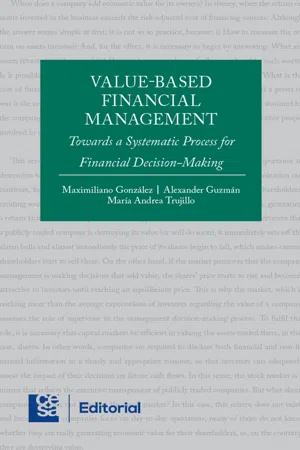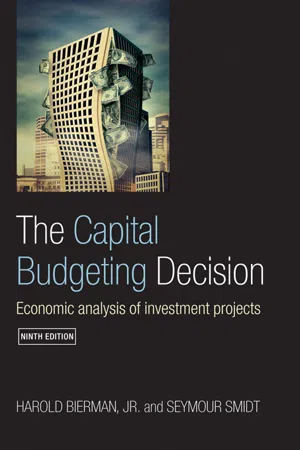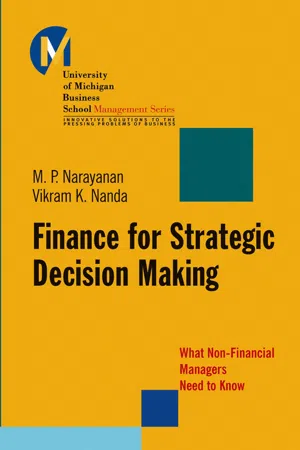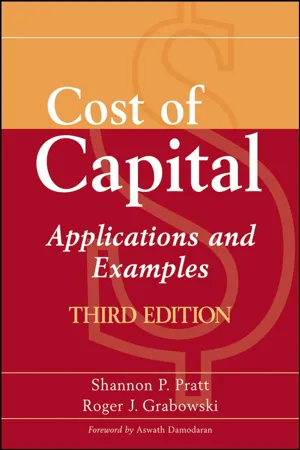Business
Adjustments in WACC
Adjustments in WACC (Weighted Average Cost of Capital) refer to changes made to the components that make up WACC, such as the cost of debt, cost of equity, and the weightings of each component. These adjustments are made to reflect changes in the company's capital structure, risk profile, or market conditions, and are important for accurately determining the cost of capital for investment decisions.
Written by Perlego with AI-assistance
Related key terms
1 of 5
10 Key excerpts on "Adjustments in WACC"
- eBook - ePub
Value-based financial management
Towards a Systematic Process for Financial Decision - Making
- Maximiliano González Ferrero, Alexander Guzmán Vásquez, María Andrea Trujillo Dávila(Authors)
- 2021(Publication Date)
- CESA(Publisher)
Chapter 5Weighted Average Cost of Capital (WACC)T his chapter addresses the topic of how to estimate the weighted average cost of capital (WACC). As discussed in the previous chapters, there are two important ratios to evaluate the performance of companies: the ROIC, which was described in Chapter 3 , and the IRR, which was addressed in Chapter 4 . It was also pointed out that the IRR on free cash flows is equivalent to the ROIC or OROA but calculated under a dynamic approach and not for one specific year; additionally, it starts from the cash obtained from operations and not from the operating profit after tax. However, these two ratios that reflect what the company is generating in terms of return do not reflect what it should generate in terms of the risk taken by financing providers (debt and equity), nor the investment opportunities available on the market. The WACC is the parameter that allows determining the minimum return the company should deliver to its financing providers.Figure 9 shows the decision-making process that is being described here.Figure 9. WACCAs already explained, the WACC or weighted average cost of capital represents the expected return for financing providers, that is, debt and equity. The accounting equation A = D + E indicates that the assets of a company are financed with a ratio of debt and equity. In both cases, both the provider of debt capital and the provider of equity capital must not only face a risk, but also give up other investment opportunities on the market; therefore, they demand to be compensated.If, for example, the company has a high risk of bankruptcy given its high level of indebtedness, the cost of debt, rD , will increase until compensating the financial creditor; on the other hand, if shareholders perceive a high operational and financial risk, the demanded return on the money invested in the firm, rE , will increase accordingly.Although risk is always given a negative connotation, it is not necessarily bad. In our context, the term risk refers to deviations from a certain expected value. Let us suppose that investment A generates two possible scenarios with equal probability: one where a payment of $110 is obtained, and another with a payment of 90. In this case, the expected value of investment A is: - eBook - PDF
- Scott Besley, Eugene Brigham, Scott Besley(Authors)
- 2021(Publication Date)
- Cengage Learning EMEA(Publisher)
11-2a Determining WACC Each firm has an optimal capital structure—a mix of debt, preferred stock, and common equity that causes its stock price to be maximized. Therefore, a rational, value- maximizing firm will establish a target (optimal) capital structure and then raise new capital in a manner that will keep the actual capital structure on target over time. In this chapter, we assume that the firm has identified its optimal capital structure, it uses this optimum as the target, and it raises funds so it constantly remains on target. How the target is established will be examined in Chapter 12. The target proportions of debt, preferred stock, and common equity, along with the component costs of capital, are used to calculate the firm’s weighted average cost of capital (WACC). The WACC simply rep- resents the average cost of each dollar of fi- nancing, no matter its source, the firm uses to purchase assets. That is, WACC represents the minimum rate of return the firm must earn on its investments (assets) to maintain its current value. To illustrate, sup- pose Unilate Textiles has determined in the future it will raise new capital according to the fol- lowing proportions: 45 VERSUSstudio/Shutterstock.com target (optimal) capital structure The combination (percentages) of debt, preferred stock, and common equity that will maximize the price of the firm’s stock. weighted average cost of capital (WACC) A weighted average of the component costs of debt, preferred stock, and common equity; the average cost of each dollar the firm uses to purchase (invest in) assets. 259 CHAPTER 11: The Cost of Capital Copyright 2022 Cengage Learning. All Rights Reserved. May not be copied, scanned, or duplicated, in whole or in part. Due to electronic rights, some third party content may be suppressed from the eBook and/or eChapter(s). Editorial review has deemed that any suppressed content does not materially affect the overall learning experience. - eBook - ePub
- Robert Irons(Author)
- 2019(Publication Date)
- Routledge(Publisher)
8 Capital Structure and the WACCCapital structure refers to the mix of debt and equity the firm uses to fund its assets. There are some large firms that use little or no long-term debt, like Facebook (with zero long-term debt 2013–2017), and others that make much more use of debt, like Tesla (with only 15% of their assets funded by equity in 2017). The different sources of funds have different costs and different levels of risk, and firms typically use the mix of debt, preferred equity and common equity that minimizes their weighted average cost of capital (WACC)—the average cost from all sources of funds, weighted according to how much of each source the firm uses to finance its operations. The overall cost the firm pays for the money it raises will be a function of the amount of money raised via each source (the weights of each source in the capital structure) and the required return associated with each source (the component costs of capital).In this chapter, we discuss the sources of funds available to the firm and the methods used to determine the cost of funds from each of those different sources. We will review how to determine the weights for each source of capital used in the capital structure, and then put it all together to calculate the weighted average cost of capital. Since the WACC is used as the discount rate for valuing projects as well as for the CFFA model for valuing the firm, this subject is closely tied to all three of the fundamental principles.The Fundamental Principles in Action
FP1 says that the value of an asset is the present value of the cash flows the asset is expected to produce. For production projects, as well as for the free cash flow model for valuing the firm, the present value is calculated using the WACC as the discount rate. FP2 states that risk and return are directly related, and so riskier assets require higher returns. In the capital budgeting process, projects of higher than average risk are discounted using the WACC increased to adjust for risk. Since the WACC is the weighted average return to the firm’s investors, this method assumes that investors will be compensated for taking on higher than average risk with a higher than average return, which is consistent with both PR1 and PR3. FP3 indicates the negative relationship between yield and value; adjusting the WACC up for above-average risk projects will cause the present value of the project’s cash flows (and therefore its value) to decrease. - eBook - ePub
The Capital Budgeting Decision
Economic Analysis of Investment Projects
- Harold Bierman, Jr., Seymour Smidt(Authors)
- 2012(Publication Date)
- Routledge(Publisher)
When capital budgeting with time discounting was first introduced in the business finance literature in the early 1950s, the common recommendation was that an investment was acceptable if the net present value was positive using the firm’s weighted average cost of capital (WACC) as the discount rate (or, equivalently, if the investment’s internal rate of return was greater than the firm’s weighted average cost of capital). Even today, more business firms are using the firm’s weighted average cost of capital as the hurdle rate than any other required return. This utilization makes the cost of capital calculation of great importance. Although we do not endorse the general use of the firm’s cost of capital in the capital budgeting process as a single hurdle rate, it nevertheless is used; thus we should compute it in a reasonable manner. The same general approach can be used to compute a project’s cost of capital or a cash flow component’s cost of capital.There is also the question of how the asset’s value is affected by the financial mix decision. The following theories deserve consideration.- The value of a firm and the consequent wealth position of the stockholders is not affected by the type of financing.
- There is an optimum capital structure and the utilization of this structure will maximize the value of the firm.
- Given the present corporate tax laws, a firm should use as much debt as possible to maximize its value and the wealth position of its stockholders.
- The use of debt offers a tax advantage but it also increases the expected costs of financial distress.
- Given the presence of personal taxes as well as corporate taxes, common stock may have tax advantages compared to debt by means of tax deferral as well as preferential treatment of capital gains and dividends.
In this chapter we examine and evaluate each of these theories and the role the weighted average cost of capital plays in the capital structure and capital budgeting decisions. The key symbols to be used are:k0 = the weighted average after-tax cost of capital ki = the before-tax average cost of debt, ki (1−tc ) the after-tax cost of debt ke = the after-tax average cost of equity capital B = the market value of the debt in the capital structure S = the market value of the stock equity in the capital structure V = the total market value of the firm: Vu is the value of an unlevered firm; VL is the value of a levered firm tc = the corporate tax rate. Definition
The weighted average cost of capital (k0 or WACC) is defined as the sum of the weighted costs of debt (ki ) and equity capital (ke ), where the weights are the relative importance of each in the firm’s capital structure and the ki and ke - eBook - PDF
- Robert Parrino, David S. Kidwell, Thomas Bates(Authors)
- 2016(Publication Date)
- Wiley(Publisher)
When a firm uses a single rate to discount the cash flows for all of its projects, some project cash flows will be discounted using a rate that is too high and other project cash flows will be discounted using a rate that is too low. This can result in the firm rejecting some positive NPV projects and accepting some negative NPV projects. It will bias the firm towards accepting more risky projects and can cause the firm to create less value for shareholders than it would have if the appropriate discount rates had been used. One approach to using the WACC is to identify a firm that engages in business activities that are similar to those associated with the project under consideration and that have publicly traded shares. The returns from this pure-play firm’s shares can then be used to estimate the ordinary shares beta for the project. In instances where pure-play firms are not available, financial managers can classify projects according to their systematic risks and can use a different discount rate for each classification. This is the type of classification scheme illustrated in Exhibit 13.4. S U M M A R Y O F L E A R N I N G O B J E C T I V E S 1. Explain what the weighted average cost of capital for a firm is and why it is often used as a discount rate to evaluate projects. The weighted average cost of capital (WACC) for a firm is a weighted average of the current costs of the different types of financing that a firm has used to finance the purchase of its assets. When the WACC is calculated, the cost of each type of financing is given a weight according to the fraction of the total firm value represented by that type of financing. The WACC is often used as a discount rate in evaluating projects because it is not possible to directly estimate the appropriate discount rate for many projects. - eBook - PDF
- Timothy Mayes(Author)
- 2020(Publication Date)
- Cengage Learning EMEA(Publisher)
All Rights Reserved. May not be copied, scanned, or duplicated, in whole or in part. Due to electronic rights, some third party content may be suppressed from the eBook and/or eChapter(s). Editorial review has deemed that any suppressed content does not materially affect the overall learning experience. Cengage Learning reserves the right to remove additional content at any time if subsequent rights restrictions require it. CHAPTER 11 The Cost of Capital 344 refer to this minimum required rate of return as the weighted average cost of capital (WACC). The WACC can be found as follows: WACC 5 w d k d 1 w P k P 1 w cs k cs (11-1) where the w’s are the weights of each source of capital and the k’s are the after-tax costs (required returns) for each source of capital. In the case of RMM, the WACC is: WACC 5 0.40(0.07) 1 0.10(0.10) 1 0.50(0.12) 5 0.098 5 9.80% which is exactly the required return that we found earlier. Determining the Weights The weights that one uses in the calculation of the WACC will obviously affect the result. Therefore, an important question is, “Where do the weights come from?” Actu- ally, there are three possible answers to this question. Perhaps the most obvious answer is to find the weights on the balance sheet. The balance sheet weights (usually referred to as the book-value weights) can be obtained by the following procedure: Find the total long-term debt, total preferred equity, and the total common equity. Add together each of these to arrive at the grand total of the long-term sources of capital. Finally, divide each component by the grand total to discover the percentage that each source is of total capital. Table 11-3 shows these calculations for RMM. The problem with book-value weights is that they represent the weights as they were when the securities were originally sold. That is, the book-value weights represent historical weights. The WACC would better represent current reality if we used the present weights. - eBook - PDF
- E. Porras(Author)
- 2010(Publication Date)
- Palgrave Macmillan(Publisher)
The implicit cost of capital of funds raised and invested by the firm may, therefore, be defined as the rate of return of the best company project, stockholder investment opportunity, or stock- holder consumption opportunity that would be foregone, if the project pres- ently under consideration were accepted. For example, if we realize a firm can always purchase its own shares in the market, this constitutes one such opportunity, with a cost equivalent to the rate of return on the repurchased shares. 66 The Cost of Capital The fact that the primary duty of managers is to maximize the value of the company for its owners means they must look for a structure that mini- mizes the overall cost of the financial resources. Wealth is maximized because valuing future cash flows to the firm or shareholder requires the discounting of those cash flows, and the smaller the divisor, the larger the present value. In addition, the wealth maximization criterion fulfils the objective of disregard- ing individual preferences, as shareholders can adjust their income streams to their own consumption choices. How to estimate the weighted average cost of capital (WACC) A review of a typical balance sheet will provide an example of how to esti- mate the WACC. However complicated the formula looks, in reality it is just a weighted addition of the capital structure components. The model is concerned with determining the components of the structure, their relative weights and the future cost of each source of capital. - eBook - PDF
The Cost of Capital
Theory and Estimation
- Cleveland S. Patterson(Author)
- 1995(Publication Date)
- Praeger(Publisher)
7 Financing Effects and the Weighted Average Cost of Capital Previous chapters have focused on the theories and processes for estimating the opportunity cost of common equity capital. It has been implicitly assumed ei- ther that projects and firms are financed only with common equity or that any risk effects caused by debt financing are impounded into estimates of k e . In this chapter, the effects of partial financing by debt and other securities are consid- ered explicitly. The first part of the chapter discusses means of adjusting net present value (NPV) estimates made assuming all-equity financing for any value increments that arise from usage of debt and similar securities in the capital structure. The second part discusses various shortcut methods for re- flecting the effects of multiple financing sources by adjusting the discount rate applicable to operating cash flows. The latter section discusses, in particular, the notion of the weighted average cost of capital (WACC), its limitations, and its estimation. I. FINANCING EFFECTS AND ADJUSTED PRESENT VALUE For a project/ which is financed entirely by common equity capital, the net present value is NPV, = - C 0 + SE[C,]/( 1 + k]') 1 (7.1) 168 The Cost of Capital where E[C t ] is the expected after-tax operating cash flow in period / and k^, assumed constant for all t, is the unlevered opportunity cost of common equity capital, which is consistent with the project's risks. As discussed in Chapter 1, the value of the firm is maximized when all projects with positive NPV are accepted. - eBook - PDF
Finance for Strategic Decision-Making
What Non-Financial Managers Need to Know
- M. P. Narayanan, Vikram K. Nanda(Authors)
- 2004(Publication Date)
- Jossey-Bass(Publisher)
You recognize the need to un-derstand how the cost of capital is determined to make effective resource allocation recommendations to the CEO. ■ WACC: A General Approach to Estimating Cost of Capital Since the cost of capital of a project is determined by what in-vestors expect to earn elsewhere at the same risk as the project, the cost of capital depends in part on the risk of the project. Therefore, one way of estimating the cost of capital of a project would be to estimate the risk of the project and use that esti-mate to compute its cost of capital. However, in practice, it is quite difficult to estimate the risk of an individual project. In practice, typically, the cost of capital of a project is esti-mated by benchmarking it to a company that is publicly traded and whose risk is similar to that of the project under consid-eration. Since the benchmark company is publicly traded, we can obtain data to estimate its cost of capital; we then plausibly assume that this is the cost of capital of the project under con-sideration. The benchmark company is called a pure play of the Cost of Capital 57 project. In many cases, the pure play might be the same com-pany that is considering the project. For example, if a cement company is considering opening another cement plant in a dif-ferent location, then it can use its own cost of capital to evaluate the project. On the other hand, if a company that has produced only software is planning to produce a line of handheld orga-nizers, it might wish to use the cost of capital of other companies that produce similar devices to evaluate the project. In your case, your company’s cost of capital is a blended average of the costs of capital of all its divisions. This cost of cap-ital cannot be taken as the cost of capital of any single project from any of the divisions. Even the chemical division’s cost of capital may be inappropriate because the division might be mak-ing products with different risk profiles. - eBook - PDF
- Shannon P. Pratt, Roger J. Grabowski(Authors)
- 2008(Publication Date)
- Wiley(Publisher)
If a controlling interest valuation is sought where it is reasonable to alter the company’s capital structure, a hypothetical capital structure may be used to estimate the WACC. There is much controversy about the potential impact that alter- ing the capital structure has on the WACC. The assumption of a single WACC to discount each increment of expected cash flow implies a constant capital structure over time. If the capital structure varies significantly over time, using a constant WACC will likely result in the incorrect value of the company or project. ADDITIONAL READING Booth, Laurence. ‘‘Finding Value Where None Exists: Pitfalls in Using Adjusted Present Value.’’ Journal of Applied Corporate Finance (Spring 2002): 8–17. Cooper, Ian, and Kjell G. Nyborg. ‘‘Valuing the Debt Tax Shield.’’ Journal of Applied Corporate Finance (Spring 2007): 50–59. Farber, Andre, Roland Gillet, and Ariane Szafarz. ‘‘A General Formula for the WACC.’’ International Journal of Business (Spring 2006): 211–218. Fernandez, Pable. ‘‘A General Formula for the WACC: A Comment.’’ International Journal of Business 12 No. 3 (2007). Massari, M., F. Rocaglio, and L. Zanetti.‘‘On the Equivalence between the APV and the WACC Approach in a Growing Leveraged Firm.’’ European Financial Management (in press). Velez-Pareja, Ignacio, Rauf Ibragimov, and Joseph Tham. ‘‘Constant Leverage and Constant Cost of Capital: A Common Knowledge Half-Truth.’’ Working paper, June 29, 2007.
Index pages curate the most relevant extracts from our library of academic textbooks. They’ve been created using an in-house natural language model (NLM), each adding context and meaning to key research topics.









